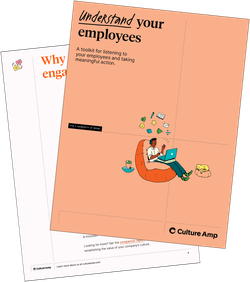
Employee engagement is a key measure of organizational health. But while employee engagement surveys are a great way to understand what impacts employee engagement over time, it’s not the only way to measure engagement.
The employee experience starts on your employee’s first day, if not sooner. They might already have an opinion, preferably favorable, of your company based on their interview experience. That’s why you need to measure and track engagement at all points of the employee experience journey. That can give your HR team a better understanding of what’s working, what’s not, and how to improve life at your company for every individual.
To help you more holistically measure engagement at your organization, we’ve put together a brief list of some helpful HR metrics you can lean on. These talent acquisition, onboarding, and employee experience metrics can help you paint the picture of employee engagement at your company.

Understand your employees
From tips to resources for leadership buy-in, everything you need to get started on employee engagement.
9 essential metrics for understanding employee engagement
Talent Acquisition metrics
1.) Time to fill: Time to fill is the period between when a company first posts a job opening and when a candidate accepts their offer of employment. It helps companies understand how long it takes to find a qualified candidate for a job posting and better understand how to expedite your hiring process. This might include leveraging employee referrals, using internal job boards, or more aggressively sourcing candidates.
2.) Time to hire: Time to hire measures the period between when a candidate applies for a job and when they accept their offer of employment. This metric helps HR teams understand how quickly (or slowly) a qualified applicant moves through the hiring process and helps identify and fix any bottlenecks along the way.
3.) Cost per hire: Cost per hire measures how much money your company spends on recruiting per hire to evaluate the efficiency and effectiveness of your hiring efforts. To calculate cost per hire, divide the total amount of money invested in your recruiting efforts (internal and external costs) by the number of hires your company has made during a given time.
These internal and external costs might include line items like recruiter salaries, job board fees, interview costs, headhunter fees, signing bonuses, etc. While the cost per hire is an interesting metric on its own, you may want to dive further to identify how role type, department, job location, source of hire, and other criteria impact your recruiting costs.
Onboarding metrics
4.) Quality of hire: Quality of hire evaluates how successful a new hire is. Every company measures the quality of hires differently by defining key indicators that examine a new hire’s level of success. These indicators might include pre-hire assessments, performance ratings, hiring manager satisfaction, etc. After identifying these indicators, add them all up as percentages and divide them by the total number of indicators used.
For example:
Quality of Hire (%) = (Hiring Manager Satisfaction + Pre-Hire Assessment Score + Performance Rating) / 3
This metric can help decrease cost per hire and turnover by ensuring you’re finding and hiring the right people for the right roles.
5.) Early turnover rate: Early turnover rate notes how many employees leave your company in their first year of employment. A high early turnover rate could suggest a disconnect between your hiring standards and role expectations or more deeply rooted management or work-life balance issues at play.
6.) HR-to-employee ratio: Your HR team is there to support employees and ensure the business’ needs are met. But, when HR teams lack proper staff support, they can quickly become spread too thin and lose the ability to make meaningful change.
An HR-to-employee ratio is the total number of HR professionals divided by the total number of employees at your company. This can be a helpful metric for measuring the efficiency of your HR department, as well as securing additional headcount or budget to grow the team or invest in more people-centric initiatives.
Employee Experience metrics
7.) eNPS: eNPS stands for Employee Net Promoter Score (eNPS) and measures whether someone would recommend their company as a great place to work. It asks employees, “On a scale of 0 to 10, how likely are you to recommend this organization as a great place to work?"
Employees who chose 0-6 are called “detractors,” or individuals who might be dissatisfied with their experience at your company and are unlikely to recommend your business to family or friends. Anyone who selects a 7 or 8 is labeled as “passive.” They are generally neutral in their commitment to your organization. Lastly, “promoters” include anyone who chose a 9 or a 10. These are you more loyal, motivated, and satisfied employees and the most likely to speak highly about your company.
To calculate the score for your business, simply subtract the percentage of detractors from the percentage of promoters (the formula ignores passives). The number you are left with is your business's eNPS and should fall within the range of -100 to +100. Just keep in mind, eNPS is not a holistic view of employee experience. It’s just one data point and indicates your team’s engagement at just one point in time, so take it with a grain of salt.
8.) Voluntary turnover rate: Voluntary turnover is when an employee leaves a role of their own accord. This might be to pursue a job at another company, transfer to another internal team, or retire. This type of turnover can be quite costly as it forces your organization to recruit a new candidate to fill the role and can upset succession planning or leave other employees to pick up additional responsibilities if there is no plan to backfill the role. This metric can also help HR teams isolate engagement issues if, say, a specific team or manager sees higher-than-average turnover rates.
9.) Involuntary turnover rate: Involuntary turnover is when an employee is let go due to their repeated failure to meet performance expectations. To calculate your company’s involuntary turnover rate, divide the number of employees who left the company by the average number of employees your business had during a specific period.
Drive organizational change with employee engagement metrics
When organizations take the time to understand the drivers of employee engagement at their organization, they can take more effective action on what’s important. Every experience an individual has with your company is crucial to shaping their levels of engagement, from their first phone screen interview with your company to their last day and everything in between. Keeping a pulse on these employee experience touchpoints can help you accurately measure employee engagement and take meaningful action on what matters to people at work.
For even more ways to listen to your employees and learn how to improve engagement at your organization, check out the Understanding Your Employees Toolkit.





